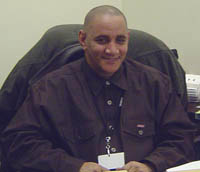 |
|
|
Politics
|
Md. Shelters Scramble to Get Homeless Out of Cold
Maryland Newsline Thursday, Feb. 8, 2007 BALTIMORE - The Helping Other People through Empowerment drop-in center, which serves Baltimore’s mentally ill homeless, usually opens at 8:30 a.m. But on days like this, when the city’s high temperature is a frigid 28 degrees, shelter Director Tom Hicks arrives earlier to start letting people in from the cold. “I come in at, like, 7 a.m.,” he said. Hicks, who was homeless once himself, understands the clients’ experiences first hand. “I know it’s cold outside,” he said. Since the beginning of the month, the Baltimore and Washington areas, like other parts of the country, have coped with dangerously frigid temperatures. February’s temperatures, so far, have been 9 degrees below the average, said Steve Zubrick, a meteorologist with the National Weather Forecast Office based in Sterling, Va.. “It is quite cold,” he said. The chronically homeless can have a particularly hard time surviving in this weather, especially during the overnight hours. So officials and homeless advocates in Baltimore City and Prince George’s and Montgomery counties – jurisdictions with the state’s highest populations of homeless -- have been scrambling to step up services to keep them from freezing on the streets.
They’ve been extending emergency shelter hours, trying to convince those living on the streets to come inside, and transporting the willing to shelters. “There should never be a time when anyone should feel as though they have nowhere to go,” said Timothy Jansen, executive director of Community Crisis Services, a nonprofit agency located in Prince George’s County. The National Alliance to End Homelessness estimated in January that nearly 8,000 people are homeless in Maryland, with the bulk concentrated in Baltimore City and Prince George’s and Montgomery counties. The count included both sheltered and unsheltered individuals. This week, though, they often allow their mostly single adult clients to stay in the hypothermia shelters during the day as well. Two of these Warm Nights shelters are housed in churches that have 25 beds each. The other two hypothermia shelters, Safe Haven and Winter Haven, have 15 and 40 beds respectively, Jansen said. In Montgomery County, the nonprofit Montgomery County Coalition for the Homeless, run in conjunction with the county’s Department of Health and Human Services, has extended its emergency shelter hours. The shelters usually operate between 5 p.m. and 7 a.m on weekdays, said Sarah Mahin, director of development and communications for the Montgomery County Coalition for the Homeless. Within the last two weeks, however, they have kept the shelters open 24 hours every day, she said. Mahin said they also stepped up their outreach program by hitting the streets and encouraging people to come inside. “This is a fairly new project. The case manager [Dierdre Harris] tries to engage people on the streets and tries to build a relationship with them,” she said. In the past month, Harris has gone out and spoken to about 20 people on the street, with half willing to be engaged in conversation and half agreeing to come in to shelters, Mahin said. Baltimore's Code Blue Shelter “We were capped for 250 people, but we extended it to 300. We had 315 people the other night,” said William Glover-Bey, director of the shelter. “We just want to try to get as many people as we can in. This weather is rough,” he added. The shelter accepts everyone regardless of any mental or substance abuse challenges they might face, said Glover-Bey. The ultimate goal, however, is to have the homeless put into more permanent housing, so keeping people from freezing temperatures at night is not an issue, Mahin said. She said progress is being made toward that goal. “[Our case worker] is seeing less and less people out on the street now. People are starting to make it to the shelters on their own more and more now.” Maryland Newsline reporter Diego Mantilla contributed to this report. Copyright ©
2007 University of Maryland
Philip Merrill College of
Journalism |

